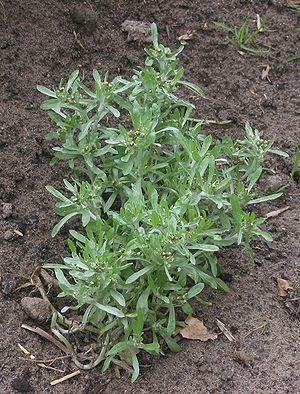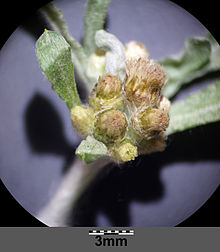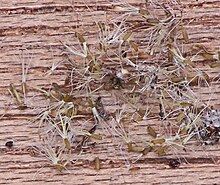Marsh dysentery
| Marsh dysentery | ||||||||||||
|---|---|---|---|---|---|---|---|---|---|---|---|---|

Marsh dysentery ( Gnaphalium uliginosum ) |
||||||||||||
| Systematics | ||||||||||||
|
||||||||||||
| Scientific name | ||||||||||||
| Gnaphalium uliginosum | ||||||||||||
| L. |
The Gnaphalium uliginosum ( Gnaphalium uliginosum L. ; Syn .: Filaginella uliginosa (L.) Opiz ) is a species within the family of Compositae (Asteraceae). It is common in the entire temperate and cool areas of the northern hemisphere .
description
Appearance and leaf
The swamp dysentery is an annual, herbaceous plant that usually reaches heights of about 10 to 15 centimeters (3 to 25 centimeters). However, unbranched miserable forms often occur. The plants are found almost exclusively in summer. The upright, usually spread from the bottom of spreading to branched stems are hairy tight to loose woolly.
The sessile, white to gray tomentose-haired leaves are usually 2 to 3 (1 to 5) centimeters long and 1 to 4 millimeters wide and linear to oblong-spatulate or obverse-lanceolate. The upper leaves are slightly wavy at the edges.
Inflorescence, flower and fruit
The flowering period in Central Europe extends from July to August. In terminal and lateral, more or less dense, clustered total inflorescences , three to ten cup-shaped partial inflorescences sit together. The flower heads are surmounted by crowded together, foliage-like bracts , which are linear, lanceolate or ovoid with a length of 5 to 15 millimeters and a width of 1 to 2 millimeters. The flower heads are cylindrical with a height of 2 to 4 millimeters. The brownish bracts are woolly hairy and membranous in the lower area; the inner ones are narrow-triangular with whitish, pointed upper ends.
The flowers are whitish-yellowish. There are about three rows of filiform ray- florets; they are only slightly longer than the tubular flowers . There are few tubular flowers.
The bald or papillous and slightly hairy achenes are about 0.5 millimeters long and weigh only 0.07 mg . They are weakly compressed. The sparse, short, wreath-shaped pappus is 1.5 millimeters long.
Chromosome set
The basic chromosome number is x = 7; there is diploidy, i.e. a chromosome number of 2n = 14.
Common names
The swamp Ruhr herb is popularly referred to as little edelweiss , and rightly so, because it is closely related to the alpine edelweiss.
ecology
The marsh dysentery is a (summer annually) therophyte that reaches a root depth of 7 to 25 centimeters. It is a crumb moisture indicator in fields.
From an ecological point of view, these are inconspicuous "cup flowers"; the filiform marginal flowers are female. Pollinators are bees .
When wet, sticky viscine threads emerge from the achenes , which allow them to spread as sticky and watery. The seeds can germinate for a long time (over 50 years). The fruit ripening begins in August.
Occurrence
The swamp dysentery is common throughout the temperate and cool areas of the northern hemisphere . (In Europe from the Mediterranean to the Arctic Circle ). It is widespread in Central Europe . It is not certain whether the species was native to North America or was introduced by humans.
It originally grew mainly in open soils on the edge of bodies of water . It is now found much more frequently than weeds in fields, in gardens or on roadsides. Here it often points to a highly compacted soil on which waterlogging can form, although it can also grow on loose soil with sufficient soil moisture. It is a cyperetalia fusci order character in Central Europe.
In the Bavarian Allgäu Alps in the Lecknertal it rises up to 1050 m above sea level.
Sources and further information
literature
- Henning Haeupler , Thomas Muer: picture atlas of the fern and flowering plants of Germany (= the fern and flowering plants of Germany. Volume 2). Published by the Federal Agency for Nature Conservation. Ulmer, Stuttgart 2000, ISBN 3-8001-3364-4 .
- Werner Rothmaler (greeting), Rudolf Schubert, Klaus Werner, Hermann Meusel (ed.): Excursion flora for the areas of the GDR and the FRG. Volume 2: Vascular Plants , 14th Edition. People and knowledge, Berlin 1988, ISBN 3-060-12539-2 .
- Guy L. Nesom: Gnaphalium : Gnaphalium uliginosum , p. 430 - same text online as the printed work , In: Flora of North America Editorial Committee (Ed.): Flora of North America North of Mexico , Volume 19 - Magnoliophyta: Asteridae, part 6 : Asteraceae, part 1 (Mutisieae – Anthemideae) , Oxford University Press, New York and Oxford, 2006. ISBN 0-19-530563-9 (section description)
Individual evidence
- ↑ a b c Swamp Ruhr herb. In: FloraWeb.de.
- ↑ a b c d Guy L. Nesom: Gnaphalium : Gnaphalium uliginosum , p. 430 - online with the same text as the printed work , In: Flora of North America Editorial Committee (ed.): Flora of North America North of Mexico , Volume 19 - Magnoliophyta : Asteridae, part 6: Asteraceae, part 1 (Mutisieae – Anthemideae) , Oxford University Press, New York and Oxford, 2006. ISBN 0-19-530563-9
- ↑ a b Description based on Hermann Wagner, 1882.
- ↑ a b c d Ruprecht Düll , Herfried Kutzelnigg : Pocket dictionary of plants in Germany and neighboring countries. The most common Central European species in portrait. 7th, corrected and enlarged edition. Quelle & Meyer, Wiebelsheim 2011, ISBN 978-3-494-01424-1 .
- ↑ a b c Erich Oberdorfer : Plant-sociological excursion flora for Germany and neighboring areas . 8th edition. Stuttgart, Verlag Eugen Ulmer, 2001. Page 920. ISBN 3-8001-3131-5
- ↑ http://www.michls.de/acker/u0207184.html ; see also discussion: Sumpf-Ruhrkraut
- ↑ Erhard Dörr, Wolfgang Lippert : Flora of the Allgäu and its surroundings. Volume 2, IHW, Eching 2004, ISBN 3-930167-61-1 , p. 581.
Web links
- Gnaphalium uliginosum L., marsh dysentery. In: FloraWeb.de.
- Marsh dysentery . In: BiolFlor, the database of biological-ecological characteristics of the flora of Germany.
- Profile and distribution map for Bavaria . In: Botanical Information Hub of Bavaria .
- Gnaphalium uliginosum L. In: Info Flora , the national data and information center for Swiss flora . Retrieved April 20, 2016.
- Distribution in the northern hemisphere according to Hultén
- Thomas Meyer: Ruhrkraut data sheet with identification key and photos at Flora-de: Flora von Deutschland (old name of the website: Flowers in Swabia )



